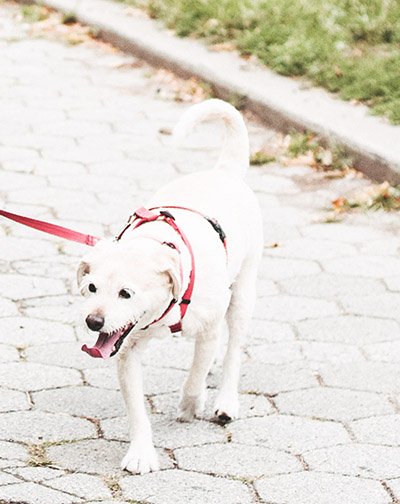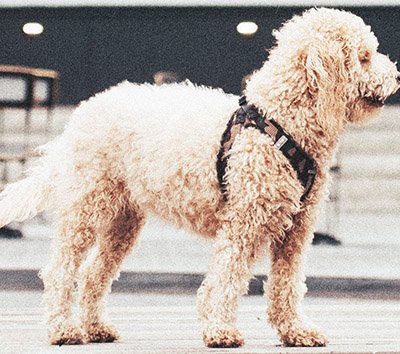Dogs are usually happy on walks but sometimes their crying can carry emotions other than joy. When a dog cries on walks, it could be signalling fear, stress, or pain. Fearful dogs often cry out of anxiety as they explore new places and unfamiliar surroundings. So if a dog cries on walks constantly this is something to explore further.
If a dog is stressed due to changes in routine or environment, they may vocalize this emotion through whimpering and crying. Finally, if your pup is in physical pain, like discomfort from arthritis or recent surgery, they may express this discomfort with crying while walking.
It’s important to recognize when your pup is expressing these feelings during their walk and take steps to soothe them if necessary. If you think your pooch might be feeling fearful or anxious about something specific on their walk like a loud noise.

Why is my dog whining on walks?
Dogs may cry on walks for a variety of reasons. It is important to identify the root cause to determine the best course of action in getting your pup to enjoy their walk and stop their cries on a walk. Common reasons why dogs may be crying include fear, anxiety, physical pain, overexcitement or simply seeking attention from you.
Some breeds tend to be naturally more anxious than others and can take some extra time and patience to adjust. If this is the case with your dog, it is important that you remain calm and patient during walks until they get used to being outdoors.
If you think your pup may be in physical pain due to an injury or illness then it’s important to seek veterinary advice as soon as possible before taking them for a walk.
If fear or anxiety is causing your pup to cry on walks, there are a few things you can do:
- Start small and take shorter routes, gradually increasing the distance as they become more confident.
- Keep walks positive by giving rewards such as treats for good behaviour.
- Use a comfortable harness and leash that will not put pressure on your dog’s body when pulled in any direction.
- Bring plenty of distractions with you such as toys, balls or treats to keep them busy during their walk if they get bored easily and start to lose focus.
- Exercise patience and remember that it may take time before your pup starts enjoying their walks and stops their crying.
How do I get my dog to stop crying when I walk?
Start by making sure your pup is comfortable while walking. Take them on shorter routes and make sure they are not over-exerting themselves. Distract them with treats, toys or games if they start to lose focus. If your dog still cries, you may want to consult a professional trainer who can give more personalized advice.
It’s important to remember that it might take some time before your pup becomes confident enough to enjoy their walks without crying. With patience and consistency, you should be able to help your dog adjust and learn how to behave appropriately outdoors.
Why is my dog suddenly anxious on walks?
There can be a variety of reasons why your dog has become anxious on walks and starts their cries when you go outside for a walk. It could be related to sudden changes in their environment such as people, animals or cars that have started appearing in their path, or it may stem from a traumatic experience they had at some point. Anxiety may also arise from separation issues if the pup is not used to spending time away from their owner.
Whatever the cause may be, it’s important to recognize and understand what triggers your pup’s anxiety in order to help them effectively address it. This can include avoiding certain areas which make them uncomfortable or providing plenty of treats and praise for when they behave properly during walks. Additionally, there are many methods available to help dogs become more confident while out and about.
Case study: My dog cries when on a leash
So I sought out help from a professional trainer. After assessing the situation, they recommended gradually introducing longer walks and exposing my pup to different environments while providing them with consistent positive reinforcement. This has made a world of difference in their behavior, and now they’re much more comfortable on our regular outings.
A dog might not like walking on a leash. It’s clear that dogs may cry during walks for various reasons, but by paying attention to your pup’s behavior and taking proactive steps to address any issues, you can help make sure their outdoor activities are enjoyable for both of you!

What to do when a dog suddenly doesn’t want to go on walks?
If your pup suddenly doesn’t want to go on their daily walks, there may be a few possible explanations. It could be that they’re feeling anxious or afraid, they may not be feeling well, or the route has become too routine and predictable for them.
To address this, it’s important to first try to understand what might be causing them distress before making any changes. This could involve taking note of anything that occurs right before they start showing signs of reluctance. Is there something specific in the environment that appears to make them uncomfortable? Are they more reluctant when they walk alone compared to when you join them?
If you can’t pinpoint the exact cause, it might help to take a break from your usual walking routes. You can also try engaging your dog in an activity that doesn’t involve walking, such as training or playing a game. This will help to break up the monotony of the same walks and give them something else to focus on. Additionally, it’s important to make sure they’re getting enough exercise throughout the day and aren’t just tired from too much walking.
Finally, you should watch for any signs of health issues or discomfort that could be causing their reluctance. Pain or anxiety can often be underlying causes for dogs who cry on walks, so it’s important to get them checked out by a vet if these don’t seem like plausible explanations. With some patience and understanding, you’ll soon have your pup back enjoying their daily walk.
What dog breed is scared of everything?
When a dog suddenly doesn’t want to go on walks, it is important to take the time to understand why. There are many potential causes, including fear, boredom, physical pain or discomfort, and general disinterest. It’s essential to try to identify what is causing the behavior before attempting any corrective actions. A dog that cries on walks is trying to say something.
Some breeds tend to be more fearful than others. Examples of dogs that may suffer from extreme fear include Chihuahuas, Yorkies, Poodles, Basset Hounds, Beagles and Dachshunds. If you recognize these traits in your pup, there are steps you can take to help them become more confident during walks. This includes introducing them slowly to new environments so they can become comfortable. Start by walking them on familiar paths and gradually increasing the distance. You can also use treats as an incentive to stay calm and positive during walks.
For dogs that suffer from boredom, it’s important to provide them with plenty of mental and physical stimulation throughout the day. Take time to play fetch, teach new tricks or even take your pup for a swim! Adding variety into their routine can help keep them engaged, and entertained and less likely to vocalize out of frustration or boredom.
To sum up
Lastly, if your dog is experiencing physical pain or discomfort while out on walks and this triggers their cries it’s critical to take them in for a checkup. Your veterinarian may have some tips and advice tailored specifically for your pup. Depending on the severity of the issue, they may recommend things like taking shorter walks, using a body harness or giving them joint supplements.
It’s important to remember that no matter the reason for your dog’s cries during walks, it can be upsetting and uncomfortable for you both. If your pup is vocalizing out of distress or discomfort, take time to address their needs before heading out on another walk!
By addressing the underlying cause of why your dog is crying while walking, you can help lessen any unease they may have during outings and make sure they are getting the most out of their daily excursions. With some patience and understanding, you’ll be able to get back to enjoying quality time together in no time!